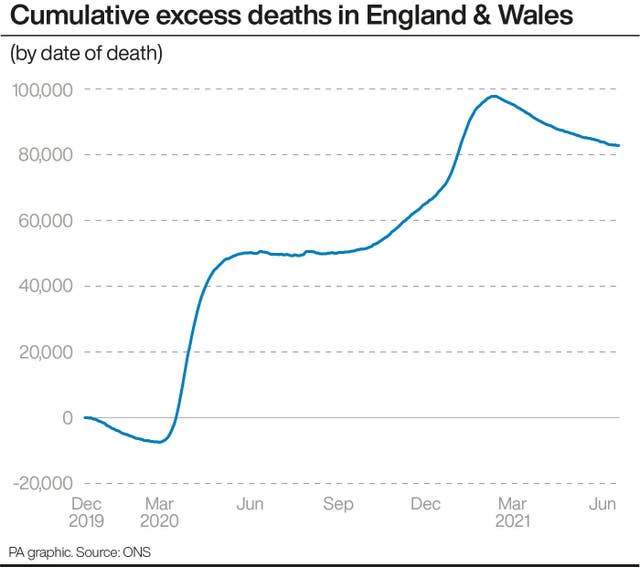Evidence points to Covid-19 causing some ‘early deaths’ at start of pandemic
The outbreak of Covid-19 might have led to some groups of people dying sooner than otherwise expected in the early stages of the pandemic, but not enough to offset the high number of deaths overall, new analysis suggests.
An event such as a pandemic can lead to the deaths of certain people – such as the very old or seriously ill – who would have otherwise been expected to die in the following weeks or months: a process known as “mortality displacement”.
But while there is some evidence of this taking place among people over 65 during the early months of Covid-19 in spring 2020, it does not account for the high volume of extra deaths that have occurred over the whole period of the virus, according to the Office for National Statistics (ONS).
At the beginning of 2020, the number of deaths occurring in England and Wales were fewer than expected, compared with the average for the previous five years.
When the pandemic began in March, however, more deaths than usual began to take place, with the number of extra fatalities – or “excess deaths” – occurring each day peaking as high as 1,800 in early April.
Some deaths in this period could have been brought forward due to the virus, mainly in older age groups and in hospitals, the ONS said.

But when deaths dropped back below average during summer 2020, this was “not enough to offset the high number in the previous period”.
There was then another period of high excess deaths during the second wave of the virus in the autumn and winter of 2020, followed by a dip below average in spring 2021 – though again this was not enough to offset the increases in the pandemic overall.
The cumulative number of excess deaths in England and Wales had reached 82,797 by July 2 2021 – the point at which the ONS analysis ends.
In more recent months, excess deaths have been recorded almost every week, despite the number of deaths involving Covid-19 being well below the levels seen at the peak of the first and second waves of the virus.
This means there are still more people dying than normal for this time of year.
“There have been suggestions that the coronavirus pandemic has led to the deaths of many ‘vulnerable’ people who would have otherwise been expected to die in the following days, weeks or months,” the ONS said.
“However, today’s analysis shows that while there is some evidence of this so-called ‘mortality displacement’ among older age groups, it does not account for the significant excess mortality seen since the beginning of the pandemic.
“In fact, we are yet to see any evidence that deaths in those aged under 65 or in private homes would have likely occurred over the following weeks or months, as deaths in these age groups and settings continue to be well above normal levels.”
In total, from December 28 2019 to July 2 2021 there were 109,009 excess deaths in England and Wales in the periods when fatalities were above average, but a deficit of only 26,212 deaths in those periods when deaths were below average.
Today we released an article on mortality displacement: https://t.co/ER0qSnB0Nb (1/n)
— Sarah Caul (@SarahCaul_ONS) October 15, 2021
The ONS also examined the cumulative percentage change in excess deaths at various points during the pandemic, compared with the expected mortality rate for the same period based on the pre-pandemic (2015-19) average.
A cumulative mortality rate of 0% would indicate that deaths are exactly what would be expected at this point in the year, based on the 2015-19 average, while a positive rate (above 0%) means deaths are higher than expected.
At the beginning of the pandemic, people aged 85 to 89 and 90 and over had highest cumulative mortality rates above the expected level.
But from February 12 2021 the rates were predominantly decreasing in both these age groups, falling to 4.0% above average by July 2 2021.
By contrast the rate for people aged under 65 remained high during much of the first half of 2021, peaking at 9.7% above what would be expected by March 26 2021, and was still at 9.6% above average by July 2.
Excess mortality in older age groups that is declining at a greater rate than younger age groups indicates some mortality displacement, the ONS said.
This is because people in older age groups are more likely to have died of other causes in the following weeks or months had the pandemic not taken place.
Those in younger age groups would have been expected to live much longer, and therefore their deaths have been “displaced” beyond the period of the ONS analysis.

 Yahoo Finance
Yahoo Finance 